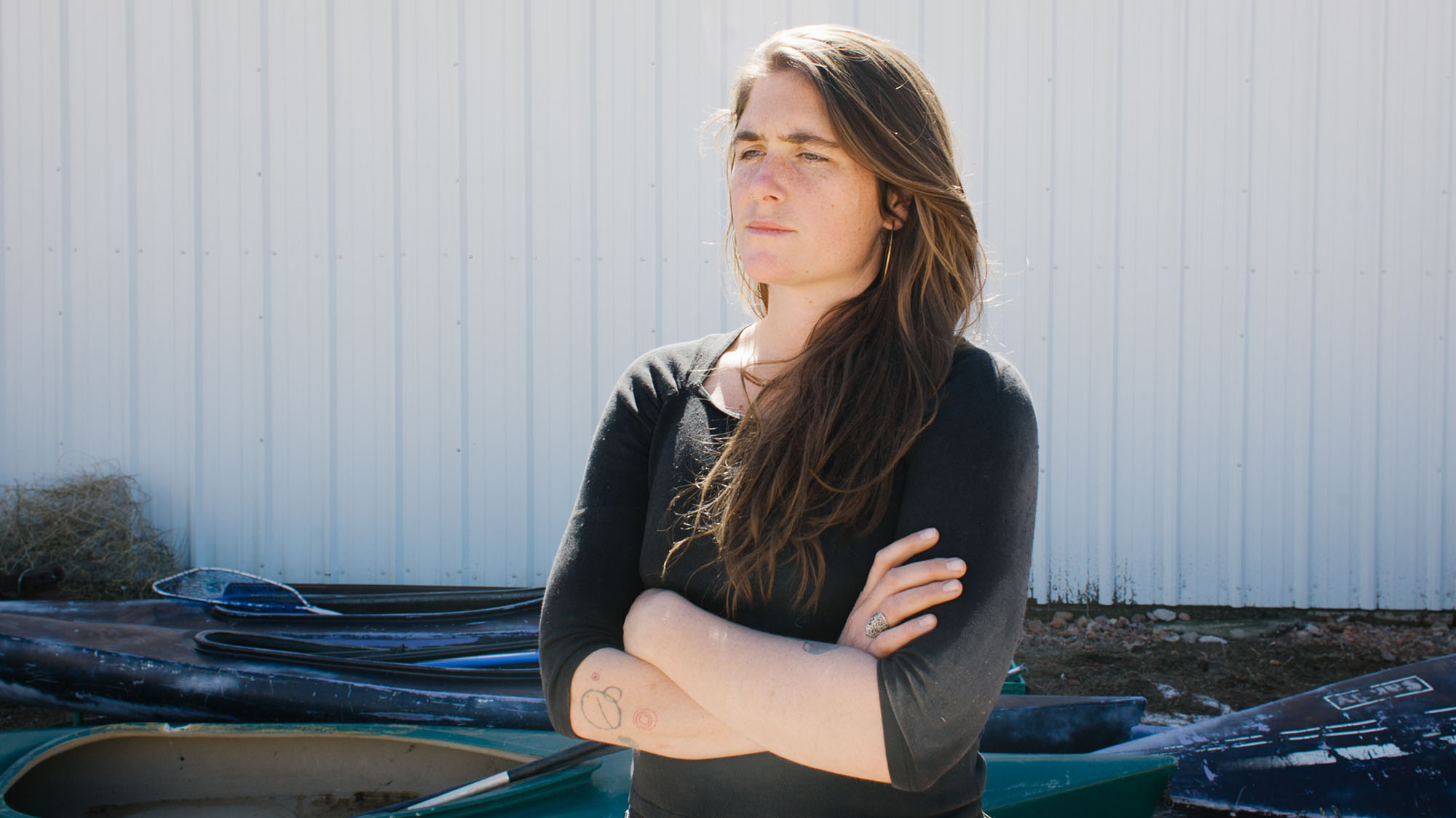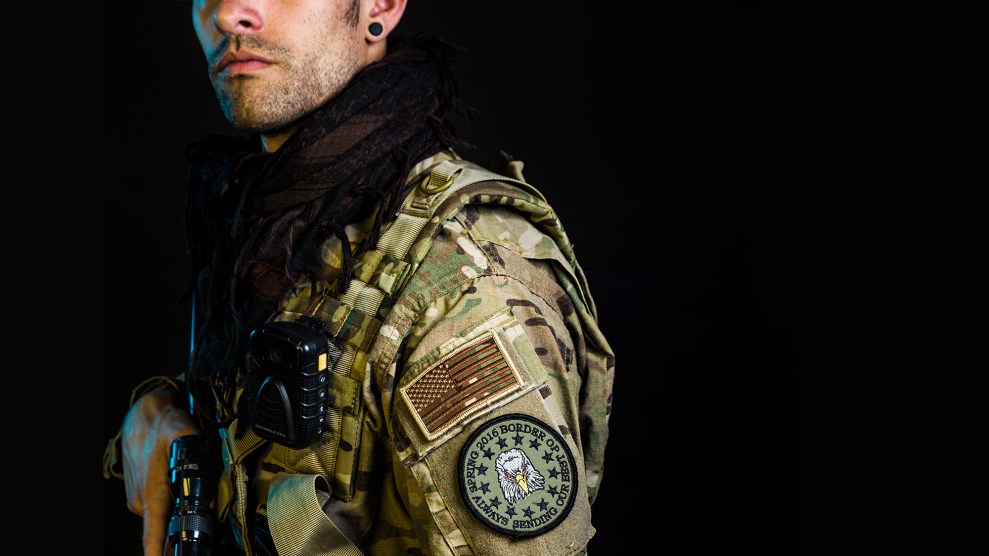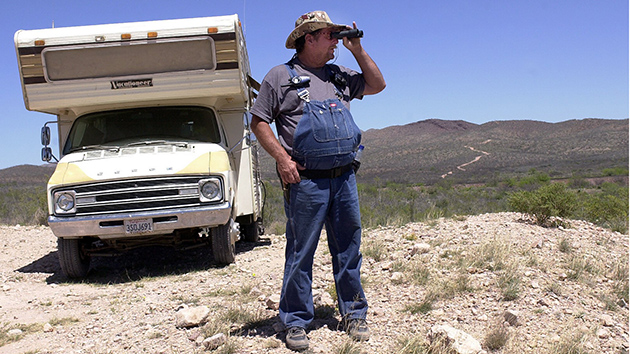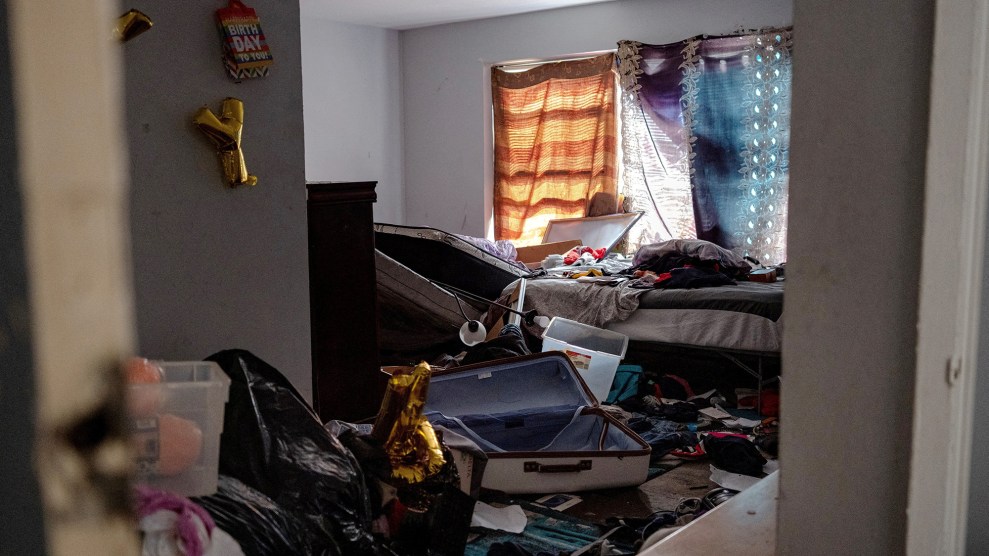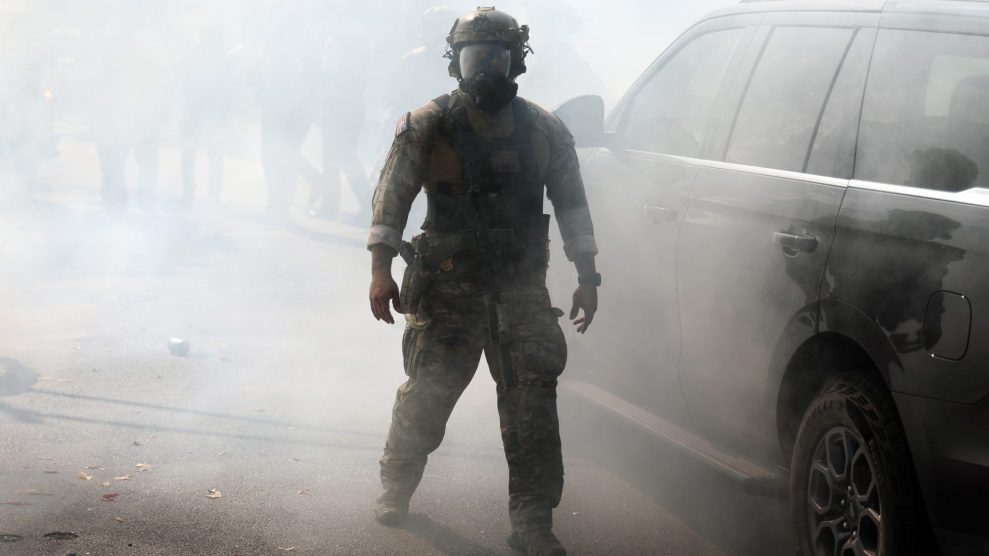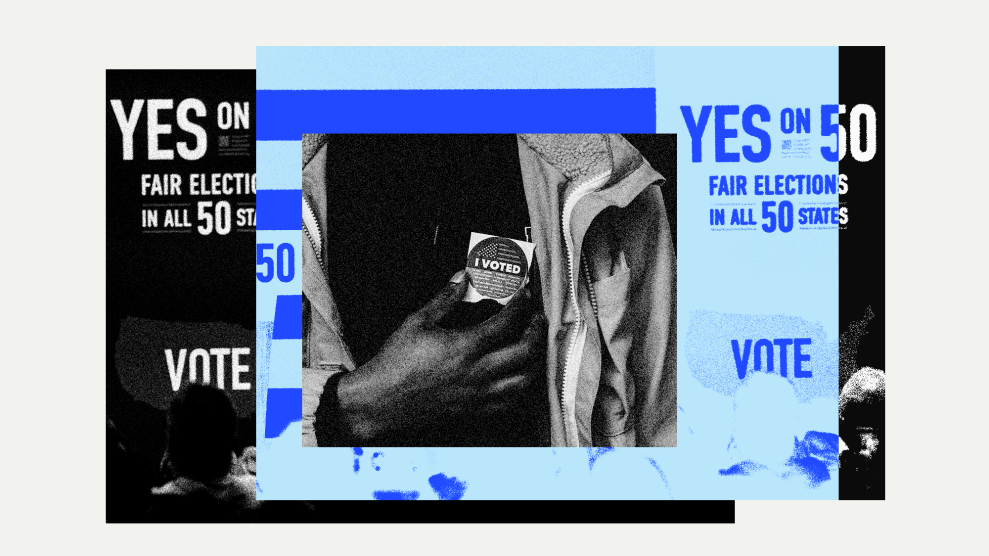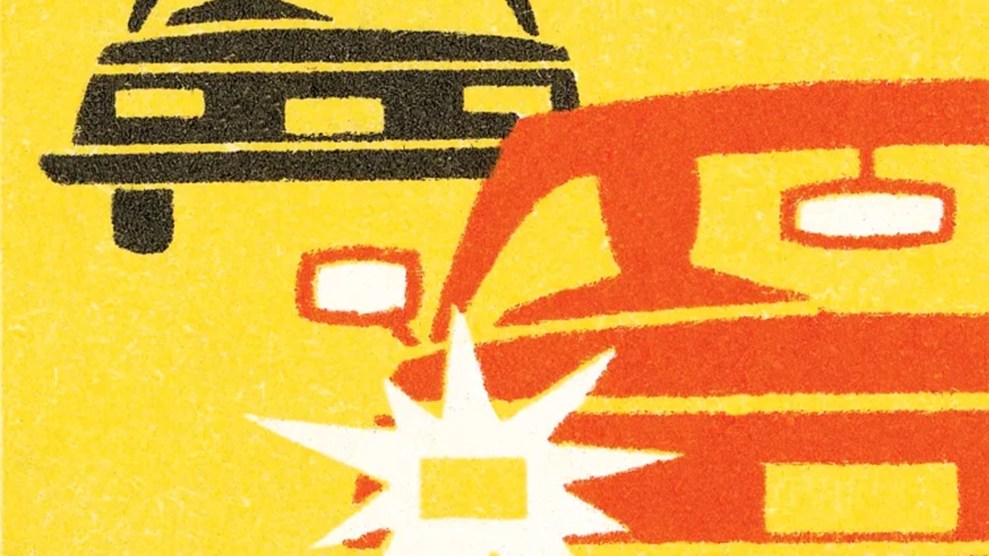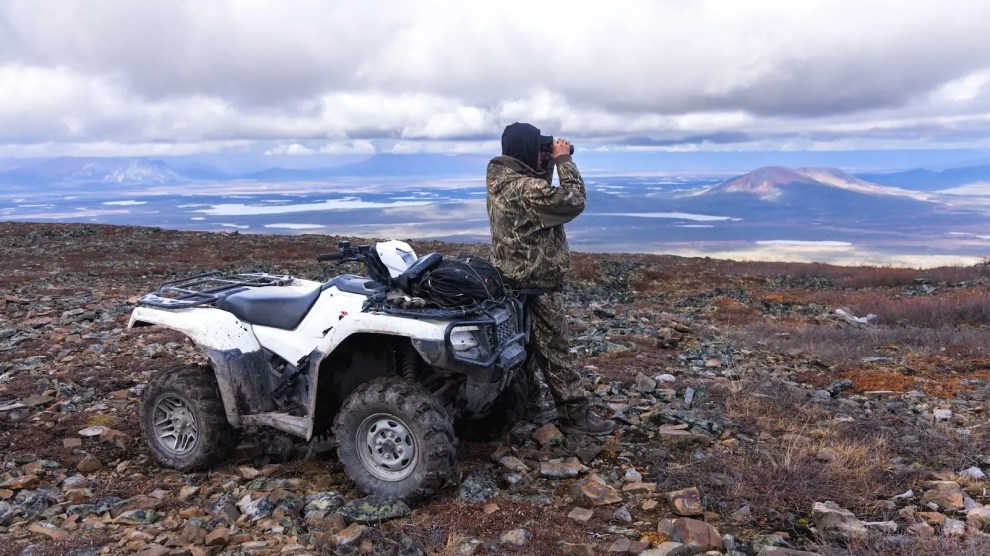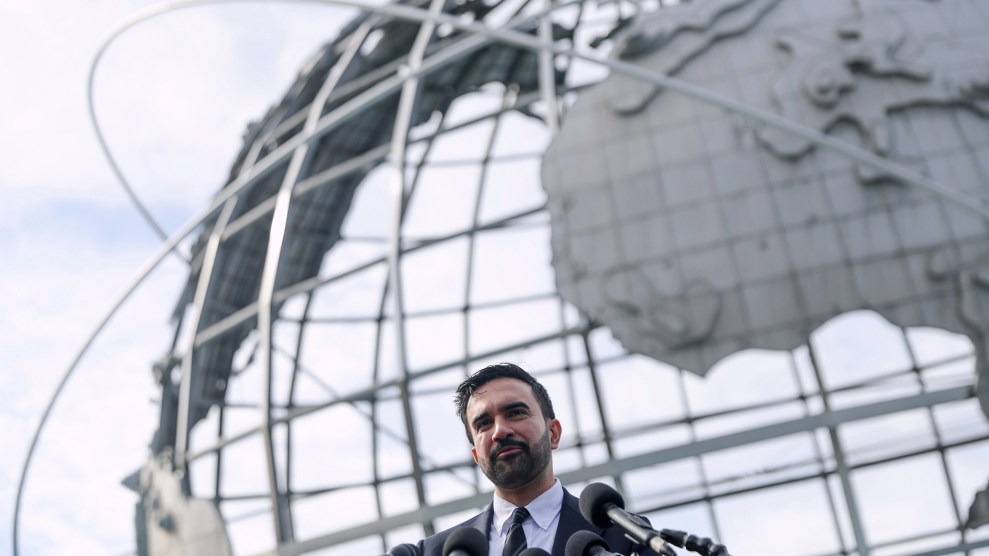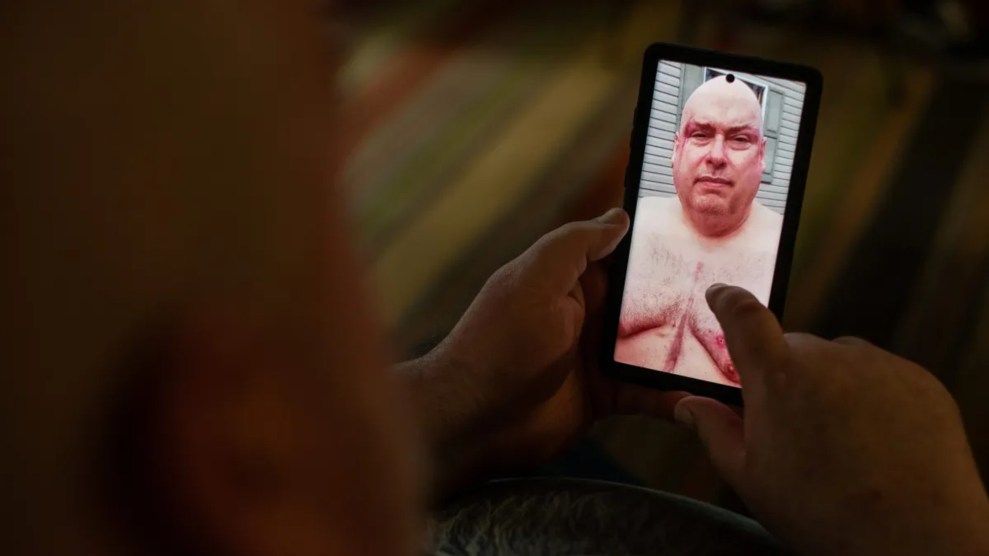In late August last year, 39-year-old Michael Lewis Arthur Meyer exited La Gitana bar in Arivaca, Arizona, took out his phone, and started recording a video for his Facebook page: “So down here in Arivaca, if you like to traffic in children, if you like to make sure women and children have contraceptives before handing them off to the coyotes to be dragged through the desert, knowing they’re going to get raped along the way, if you’re involved in human trafficking or dope smuggling, these individuals have your back.”
Listen to journalist Eric Reidy discuss what went down in this border town and how the rest of America can learn from its success, on the latest episode of the Mother Jones Podcast:
Meyer, who had a trim red beard, dark sunglasses, and a camouflage American flag hat, aimed his cellphone camera at a wooden awning on a small white bungalow across the street from La Gitana, panning between two signs with the words “Arivaca Humanitarian Aid Office” and “Oficina De Ayuda Humanitaria” in turquoise letters.
The video went on for nine and a half minutes, as Meyer, the leader of a group called Veterans on Patrol, which had more than 70,000 followers on Facebook, talked about stopping border crossers and searching abandoned mineshafts for evidence of trafficked women and children. Every couple of minutes he would return to the aid office.
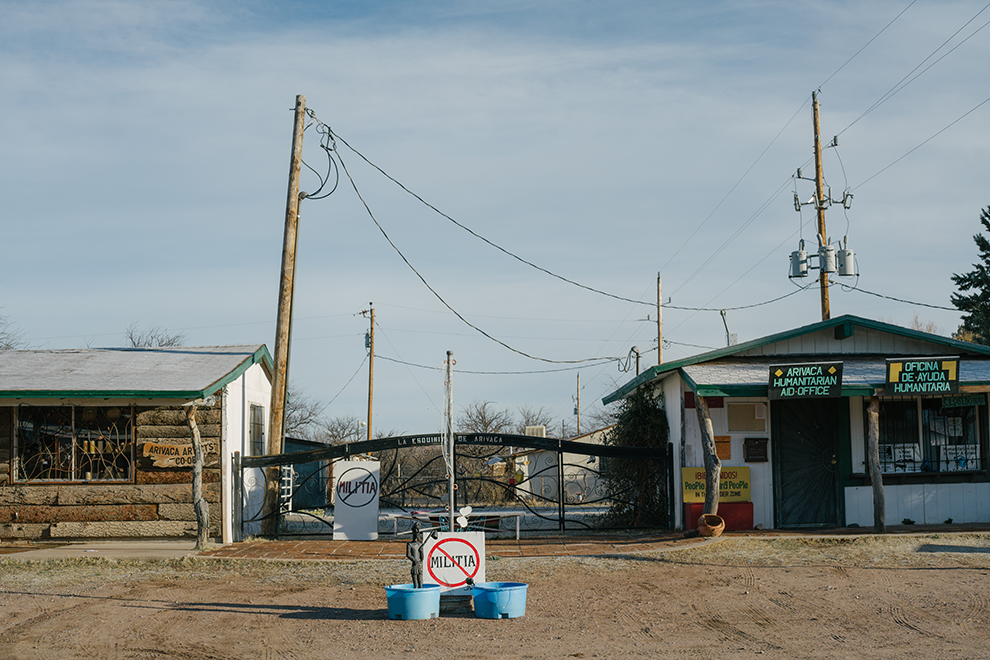
Daniel Tepper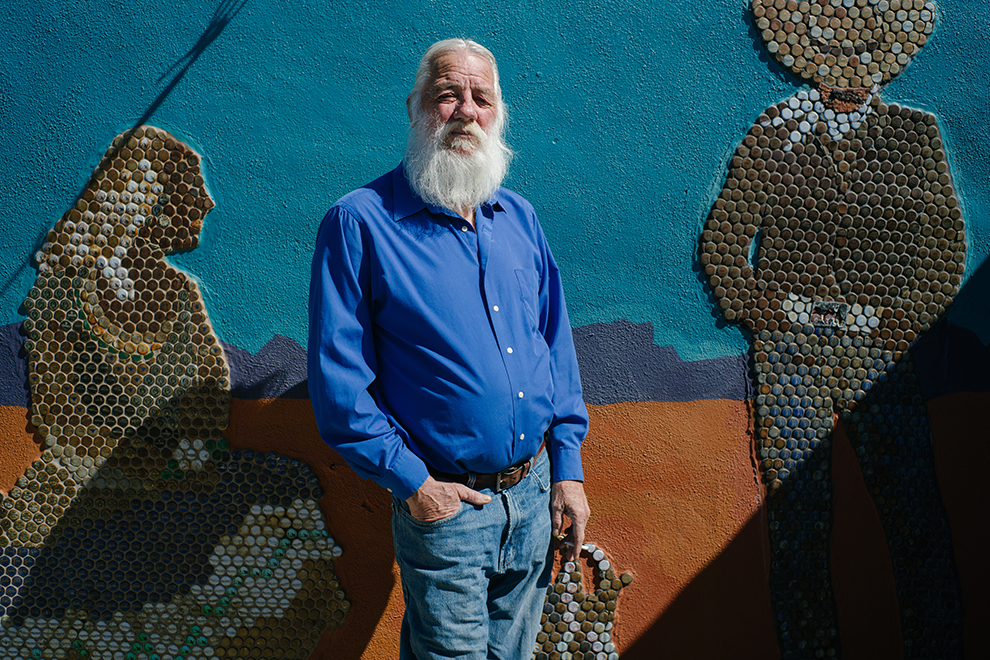
Daniel Tepper
“If you’re ever down here in Arivaca,” he told his audience, “if you want to know who helps child traffickers, if you want to know who helps dope smugglers, if you want to know who helps ISIS, if you want to know who helps La Raza, MS-13, any of ’em, any of the bad guys, these people help ’em.”
The claims were false and outrageous. But Meyer had an audience, and people in town were well aware of how media-fueled anti-immigrant vitriol and conspiracies could spill over into real-world violence. It had happened there before.
Arivaca sits just 11 miles north of the Mexico border in a remote area of the Sonoran Desert. For about two decades, anti-immigrant vigilante groups have patrolled the region to try to remedy what they perceive as the federal government’s failure to secure the border. In 2009, the leader of one of these groups and two accomplices murdered two residents—a little girl and her father—during a home invasion and robbery planned to fund their activities. Meyer’s video brought that trauma back and was quickly followed by a series of incidents revolving around various vigilante groups, La Gitana, and the humanitarian aid office. When I visited in mid-September, the town was clearly on edge. “If we don’t do something about [the situation], we’re going to have bodies here again,” Arivaca’s unofficial mayor, Ken Buchanan, told me.
Shortly before making his video, Meyer had been sitting in La Gitana with several volunteers from Veterans on Patrol. Megan Davern, a 30-year-old meat cutter with work-worn hands and long brown hair, was tending bar. She had heard that a rancher living along the border was having issues with a vigilante group trespassing and flying drones over his property.
“I walked into the bar at four o’clock one day to start a shift, and I saw this big group of people in fatigues with empty gun holsters and a drone on the table, and I felt it was probably them,” Davern recalled.
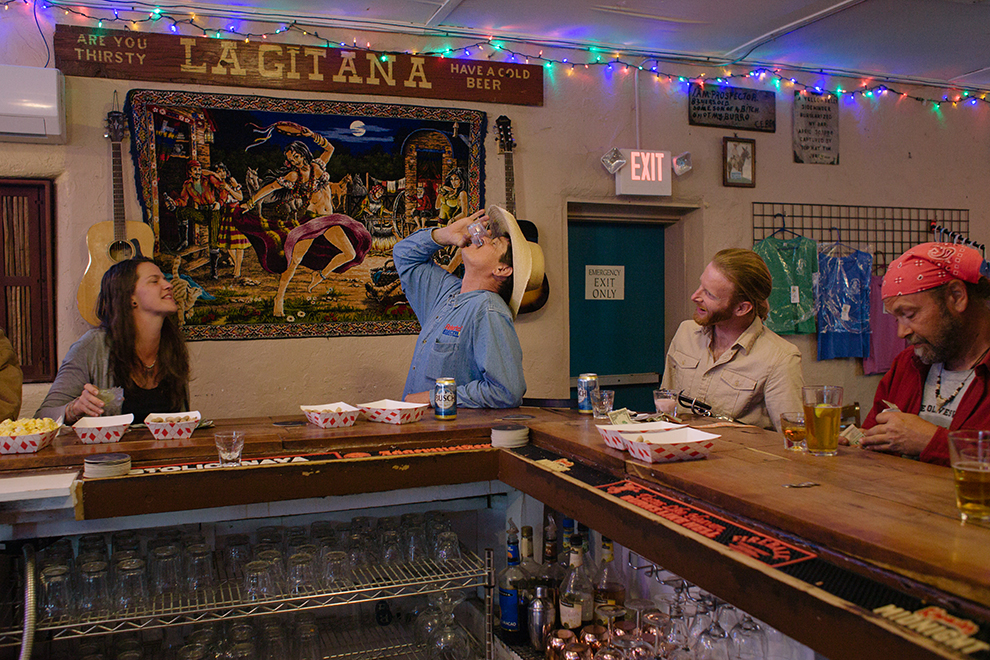
Daniel Tepper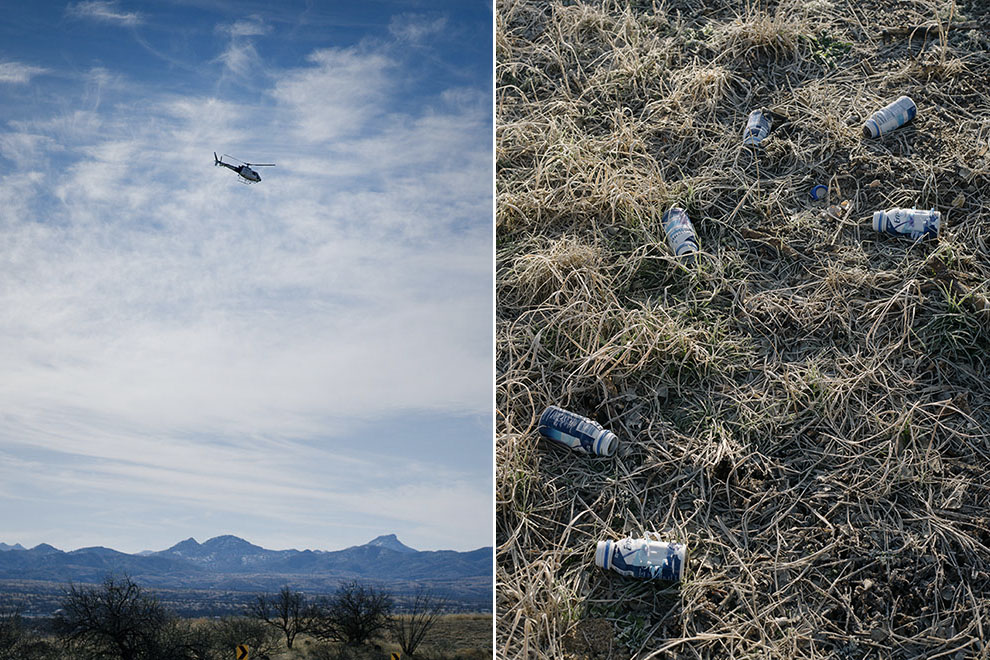
Daniel Tepper
Davern had heard the group’s name before and quickly did some internet research, reading highlights as the men drank. The group was founded to provide support to homeless veterans. Then, in May 2018, Meyer—who is not a veteran and has a criminal history—claimed he had discovered a child sex trafficking camp at an abandoned cement factory in Tucson. The camp, he said, was part of a pedophilia ring, and on his Facebook page he shared posts linking it to the Clintons, George Soros, and Mexican drug cartels.
Meyer, who showed up for rancher Cliven Bundy’s 2014 armed standoff with authorities in Nevada and was present during Bundy’s sons’ occupation of an Oregon wildlife refuge in 2016, declined an interview request. But the story he was spreading mimicked right-wing conspiracies like Pizzagate and QAnon, and though Tucson police investigated and debunked his claims, Meyer gained tens of thousands of social-media followers. With donations of supplies and gift cards pouring in from supporters, he vowed to gather evidence and save the women and children he claimed were being victimized.
Davern watched as Meyer and the other Veterans on Patrol volunteers left La Gitana and started filming the first video. Toward the end of the video, she stepped out of the bar to confront them. “We’ve been hearing about you for a long time,” she said, as Meyer turned the camera on her. “I’d appreciate if you don’t come in anymore.”
Banning Veterans on Patrol, Davern told me, was an easy decision: “We have a strict no-militia policy at the bar because of the history of militia violence in this town.”
Arivaca is a quirky place. To start with, it’s unincorporated, which means there’s no official mayor, no town council, no police force. The 700 or so residents are an unlikely mix of miners, ranchers, aging hippies, artists, and other folks who stumbled across the odd little community, became enchanted, and decided to make it home. A single road runs through it, linking an interstate highway to the east and a state highway to the west. The next town is 30 minutes away; Tucson is 60 miles north.
Jagged hills covered in scraggly mesquite spread in every direction until they meet towering mountains at the distant southern horizon. The vast landscape swallows up the dividing line with Mexico, but the presence of the border looms large.
By the early 2000s, a federal policy called Prevention Through Deterrence had pushed border crossers from urban areas to more hostile terrain like the desert around Arivaca. Migrant deaths skyrocketed, and Arivaca eventually became a staging ground for volunteers caching water and food in the desert. Some settled down, and residents opened the humanitarian aid office in 2012.
The border crossers also caught the attention of vigilante groups, many of which had formed in the late ’90s in Texas and California, and which ranged from heavily armed paramilitary-type organizations to gangs of middle-aged men sitting on lawn chairs with binoculars. “They realized that ground zero was really on the Arizona border,” said Mark Pitcavage, who researches right-wing extremism at the Anti-Defamation League.
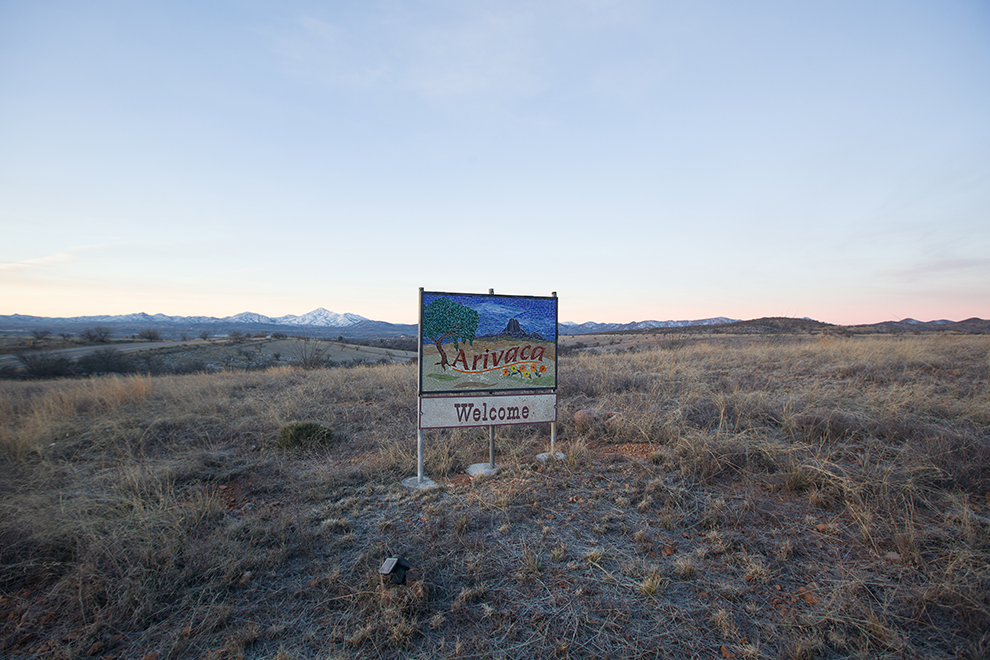
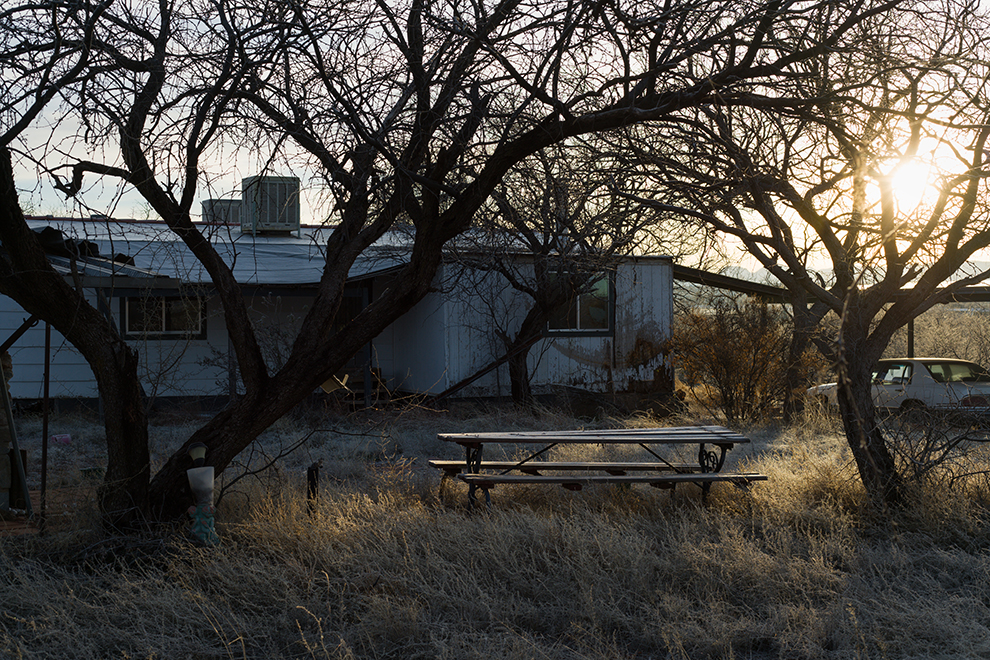
Daniel Tepper
One group known as the Minutemen started organizing Arizona border watches in 2005. “It was a big deal in the press,” said Heidi Beirich, a hate group expert at the Southern Poverty Law Center. Beirich credits the Minutemen with helping mainstream the demonization of undocumented migrants, calling the media-savvy group “probably the thing that started off what ultimately becomes Donald Trump’s anti-immigrant politics.”
But by 2007, the organization was splintering. One spinoff, Minutemen American Defense (MAD), was led by a woman named Shawna Forde, a name that no one in Arivaca would soon forget.
Just before 1 a.m. on May 30, 2009, Forde and two accomplices murdered nine-year-old Brisenia Flores and her 29-year-old father, Raul, in their home. They also injured Brisenia’s mother, Gina Gonzales, before she drove them away by grabbing her husband’s gun and returning fire.
Raul Flores was rumored to be involved in the drug trade, and Forde, a woman with a long criminal history, had devised a plan to rob his home and use the money to finance MAD.
The murders shook Arivaca. “The whole town has those emotional scars,” Alan Wallen, whose daughter was friends with Brisenia, told me.
The day that Meyer filmed that first Facebook video in Arivaca, Terry Sayles, 69, a retired schoolteacher with a long-standing research interest in far-right groups, was at his home in Green Valley, some 45 minutes away. Sayles had been following Veterans on Patrol since the cement plant conspiracy theory first surfaced. When he saw Meyer’s video outside La Gitana, he called the bar with a warning. “You guys know that you’re on Facebook?” he asked.
“Oh, great,” Davern remembered thinking. Until then, she hadn’t realized Meyer’s video was online. “I didn’t know what the ramifications would be. Were people going to come into my work and harass me? Threaten me with violence? Were they going to find out where I live?”
Around the time of Davern’s confrontation outside the bar, La Gitana put up a sign saying that members of border vigilante groups were not welcome inside. It didn’t mention Veterans on Patrol but instead singled out another group: Arizona Border Recon (AZBR).
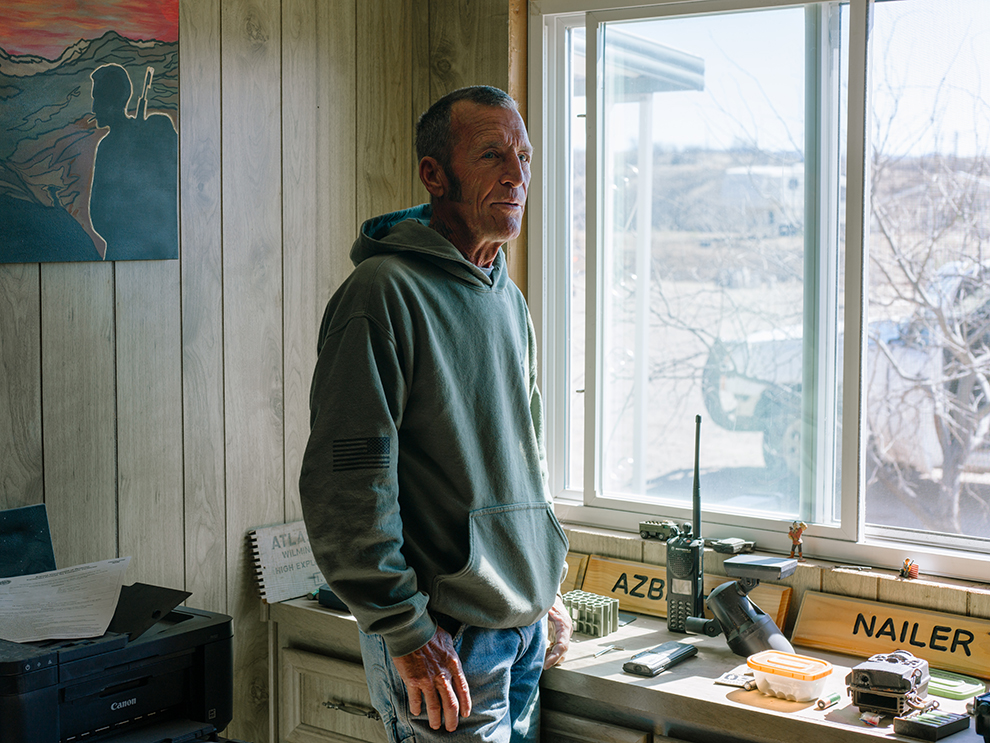
Daniel Tepper
Tim Foley, the leader of AZBR, had moved to Arivaca in the summer of 2017. Before starting the group in 2011, Foley, who has piercing blue eyes and leathery skin from long hours in the sun, worked construction jobs in Phoenix until 2008, when the financial crisis hit. “Everything fell apart,” he told me over the phone.
Foley said that after years of seeing immigration violations on work sites go unpunished, he went down to the border and decided to dedicate himself to stopping undocumented crossers. The Southern Poverty Law Center considers AZBR a nativist extremist group, but Foley now says his main mission is gathering intelligence on Mexican drug cartels.
Just before I visited Arivaca, Foley was in Washington, DC, speaking at “The Negative Impact of Illegal Alien Crime in America,” a rally hosted by families of people killed by undocumented immigrants. Other speakers included former Maricopa County Sheriff Joe Arpaio, who is also a Trump pardon recipient; presidential adviser Kellyanne Conway; and Rep. Steve King, a Republican from Iowa with a history of racist and anti-immigrant rhetoric.
A few days after Meyer filmed his video, a BearCat armored vehicle—the kind used by SWAT teams—came rolling into Arivaca. It had a mock .50-caliber machine gun affixed to a turret on its roof and belonged to the Utah Gun Exchange, a marketplace and media company based near Salt Lake City with a mission to build what one of its co-owners, 46-year-old Bryan Melchior, described as “web platforms that allow free speech and that promote and protect the Second Amendment.”
Before coming to Arivaca, the group had followed survivors of the Parkland high school shooting around the country during the teens’ “March for Our Lives” tour. But after President Trump threatened to shut down the government over funding for his border wall, Melchior shifted his attention. “Ultimately, we came here to tell stories from the border, and that’s what brought us to Arivaca, because there are some outspoken public figures here. Tim Foley is one of them,” Melchior told me.
Melchior, stocky with a scruffy salt-and-pepper beard and an ever-present sidearm, and his crew decided to get dinner at La Gitana. Davern was tending bar and asked the group what they were up to. When Melchior said they were a media company in town to tell border stories and that they were in touch with Foley, “the whole thing went to hell in a handbag,” he recalled.
Davern said she left their initial conversation feeling optimistic that the Utah Gun Exchange’s platform could be a good avenue to reach a different audience with information about what life was actually like at the border. But when she found out it had a channel called BuildTheWallTV, she changed her mind.
Melchior was down by the border when somebody sent him a picture of a new sign in La Gitana’s window listing the Utah Gun Exchange and Veterans on Patrol as groups that were not welcome. He later went into La Gitana with an open container of alcohol from a store across the street to ask about the sign. The interaction did not go well.
The next day, Meyer came back to town ready to film again. Playing to an audience watching in real time on Facebook Live, he walked up to La Gitana, showed the signs hanging in the window, and knocked. “Do you stand by your convictions to tell tens of thousands of supporters [that they’re not welcome]?” he asked the bartender working that day.
“Sure. Absolutely,” she replied.
Meyer went on to say that Veterans on Patrol was going to build a wall around Arivaca to make it part of Mexico. He then walked across the street to again film the humanitarian office: “This town’s made it apparent they don’t want us. They’d rather have the illegals crossing over. They’d rather help traffic the children and the women.”
To many Arivaca residents, it felt like things were building toward cataclysm. “People are terrified,” Davern told me. “These people come to town and they’re threatening. Extremely threatening.”
So they called a town meeting. It was held on September 9, and about 60 people came. Terry Sayles, the retired teacher from Green Valley, was there. He suggested that the town report Veterans on Patrol’s page to Facebook. The residents set up a phone tree in case they needed to quickly rally aid—local law enforcement is at least an hour away. Kelly and a couple of others formed a neighborhood watch of sorts. “We had a strategy that we had rehearsed so that if in fact there was some attempt by somebody to do harm, we could de-escalate it in a hurry and quietly defuse it,” he said.Arivacans weren’t so much concerned about Foley, Meyer, or Melchior, but about their followers, who might see their inflammatory videos and posts about Arivaca and take matters into their own hands. “Our greatest fear was some person incensed at the thought of this community engaged in sex traffic would come out here and have a shootout at our local tavern,” Dan Kelly, a Vietnam War veteran who lives in Arivaca, told me.
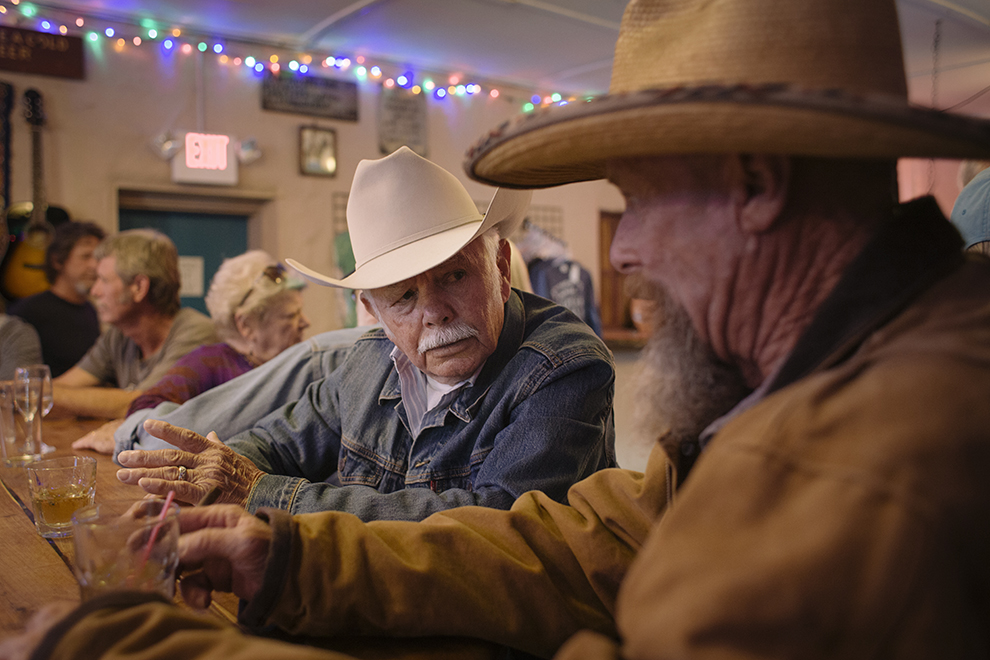
Daniel Tepper
One of the most important things, though, was channeling the spiraling fear into a productive reaction. “We worked hard to separate the emotional response to it and try to look at it logically and coldly,” Kelly said. “The visceral side, the emotional side, was the impetus to get organized and take a rational response.”
Their containment approach worked. A couple of days after the meeting, Veterans on Patrol’s main Facebook account was taken down, stripping Meyer of his audience. The Utah Gun Exchange eventually packed up and left. Many people had refused to talk to the outlet. “Arivaca is the most unwelcoming town I’ve ever been to in my life,” Melchior complained to me.
In January, Melchior was charged in Utah with felony drug and weapons possession. Meyer also faces legal trouble, some of it stemming from videos he took of himself trespassing on private property around Tucson. He currently has several cases pending in the Pima County court system.
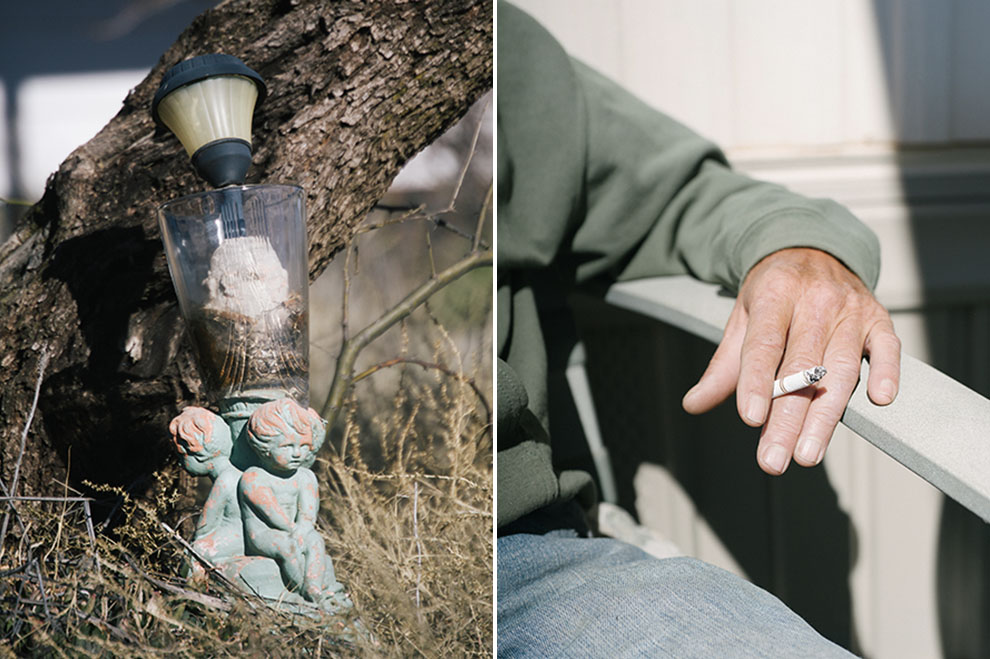
Daniel Tepper
“There’s been significantly less obvious militia activity in Arivaca, which I contribute to a victory on our part,” Davern told me during a recent phone call. “There’s a lot less fear going around, which is great.” Town meetings continued for a while but have stopped for now. But to Davern, as long as Tim Foley is still in town, the issue isn’t resolved. “That person needs to leave,” she said, describing him as a magnet for conflict. High Country News detailed an incident in early March when locals eager to keep the peace dissuaded a group of reportedly self-described anarchists who had come to town to confront him.
Foley knows what Davern and others in Arivaca think about him but insists there’s a silent majority in town that supports his presence. “They can keep calling me the bad guy. I already know I’m not, or else I still wouldn’t be walking the streets,” he told me. “I’m not moving. I’m staying in Arivaca. They can keep crying for the rest of their lives. I really don’t care.”
Even at the height of their fear, a question hovered over the town’s residents: Were they overreacting?
It’s a question more people across the country confront as they wake up to the reality of right-wing extremism and violence. When I was in Arivaca, the answer was clear to Clara Godfrey, whose nephew Albert Gaxiola was Shawna Forde’s accomplice in the Flores murders. He and Forde had met at La Gitana. “We can never say, ‘We didn’t know,’ again,” Godfrey told me. “If anything happens, we have to say, ‘We knew, and it was okay with us.’”
